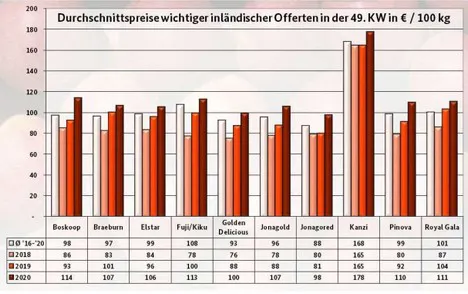Native apples dominated as usual. Elstar, Jonagold and Boskoop were available primarily, while the presence of Fuji increased continuously. Nicoter appeared in Berlin, costing €1.80 per kg. From Italy came mainly Golden Delicious and Granny Smith, Granny Smith and Braeburn arrived from France. The complementary Dutch and Belgian shipments were quite cheap and therefore saw a friendly demand.
Sales options improved overall, especially red fruits, excellent for decoration purposes, were increasingly in demand. Prices did not change significantly. There were some price increases, in Munich somewhat more often than elsewhere. Meanwhile in Cologne, local Rubinettes und Boskoops dropped in price. In Berlin, prices for club varieties from Italy fell.

Pears
Italy dominated with Abate Fetel, Santa Maria and Williams Christ. Business was quite slow. Generally, supply was in harmony with demand.
Table grapes
Italian batches lost noticeably in relevance, as Italias, Crimson Seedless and Red Globes saw only limited availability. Spanish Aledos, Crimson Seedless and Napoleons could be sold quite quickly in some cases.
Oranges
Spanish Navelinas outclassed the blonde oranges in terms of quantity. The organoleptic characteristics of these oranges rarely left anything to be desired, so sales went well.
Small citrus fruits
Spanish clementines predominated in the ranges, followed by Turkish Satsumas and Italian clementines, which were mostly available with leaves. Deliveries from Greece and Morocco had a complementary character.
Lemons
Spanish Primofiori dominated. The cool weather accelerated business. Supply and demand were often balanced, so that prices did not change significantly.
Bananas
The stores were quite different, because on the one hand the cool weather improved sales, but on the other hand the customers focused more on citrus fruits.
Cauliflower
French supplies prevailed. In terms of importance, Italian deliveries came in second. Dutch, Belgian, Spanish and the last German batches completed the ranges.
Lettuce
Iceberg lettuce came in exclusively from Spain. Its availability expanded and mostly exceeded the demand. There had to be discounts in order to avoid stocks.
Cucumbers
Spanish shipments outweighed the ones from Belgium. Demand was limited, because the hospitality industry did not buy up the usual quantities. As a result, prices dropped, in some cases quite significantly.
Tomatoes
A rich assortment was available, with Morocco, Spain, Belgium and the Netherlands being the main suppliers. Sales facilities were limited and could not keep up with supplies.
Sweet peppers
Spanish offers were most available. Turkish and Moroccan imports rounded of the range. Although demand was not particularly great, prices generally rose somewhat.
Source: BLE
